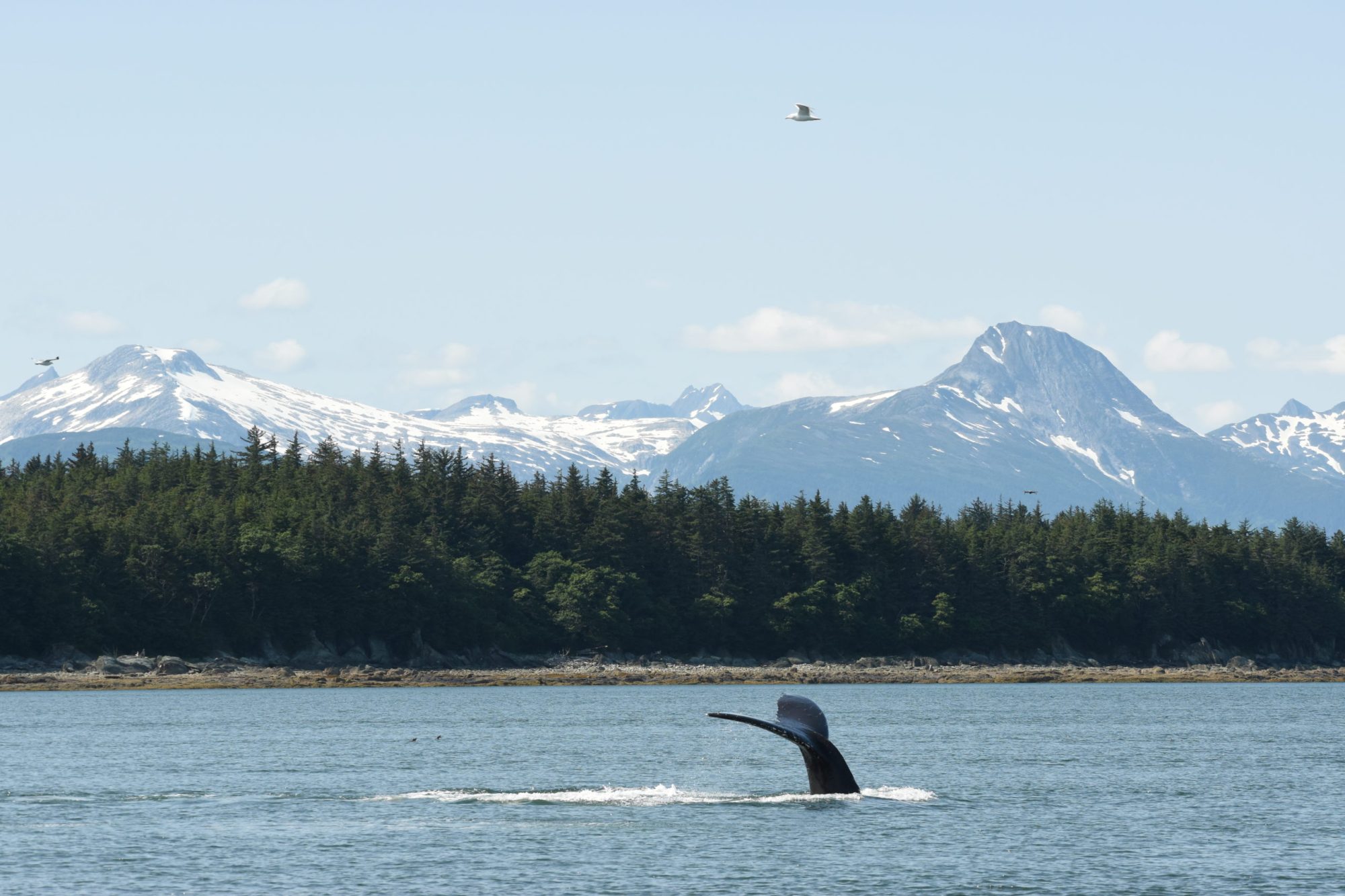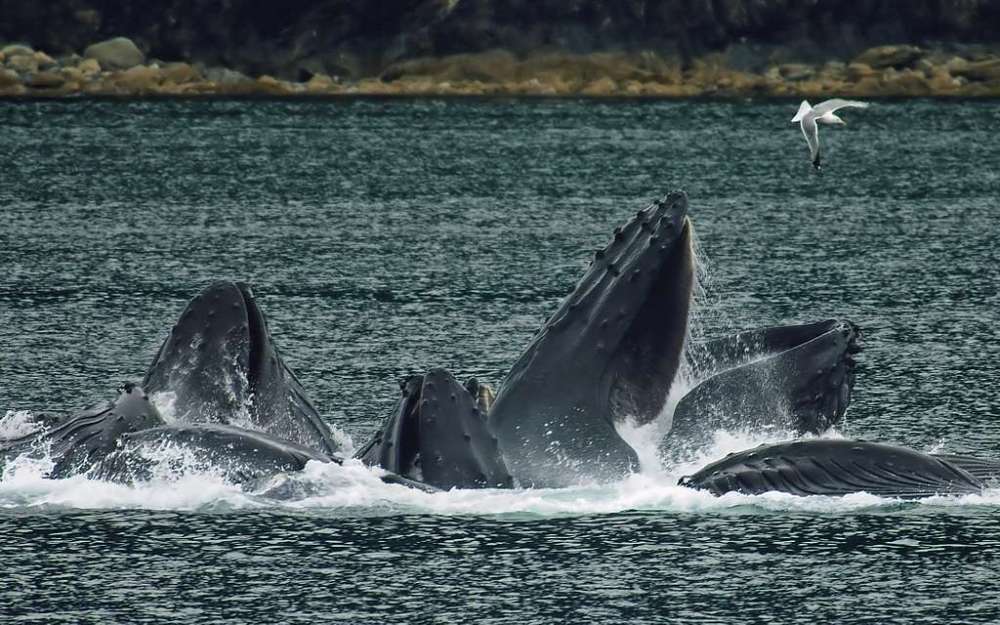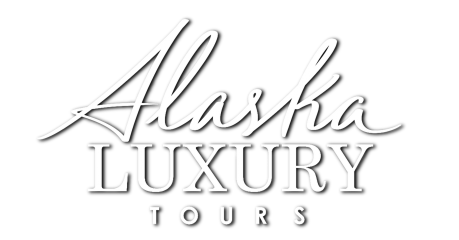Humpback Migration: From Tropical Waters to Alaska

Humpback whales live and migrate throughout all of the oceans on our planet, traveling great distances every year. The humpback migration is one of the longest of any mammal in the world, with some populations swimming as much as 5,000 miles. They travel to and from warm, tropical breeding grounds and productive, colder feeding grounds. That said, some traverse even greater lengths like a humpback scientists refer to as Frodo. Frodo swam nearly 7,000 miles from Saipan, in the Mariana Islands, to Sayulita, Mexico, in 2017 and 2018, according to a recent study published in Endangered Species Research. The previous record was just over 6,000 miles with a female swimming from Brazil to Madagascar in 2001.

whale watching in Juneau, Alaska credit: K.C. Dermody
The humpbacks you see in Southeast Alaska, including the waters around Juneau, primarily travel from Hawaii and Mexico where they spend their winters. Some breed in the main Hawaiian Islands, with the greatest concentration in the channel between Maui and Lahaina, while others breed along Mexico’s Pacific Coast before making their way on a roughly 3,000-mile journey.
While females are calving, they prefer the warm, shallow waters near coastal shores or offshore reef systems. When not calving, they’re following their food sources that are in the cold, nutritionally-productive waters like those in Southeast Alaska.
Humpback Whale Behaviors
The odds of witnessing certain behaviors when watching humpback whales tend to vary depending on their location. For example, in Hawaii, mothers and their babies are often seen on the surface, tail slapping and breaching. Their escorts drive off competition while competition pods take part in interesting physical rituals. Mothers have their calves here so that they can stay warm while they nurse, producing blubber that will be necessary to survive the cold waters of Alaska.
While in Hawaii, the whales don’t eat. But after the humpback migration brings them to Alaska, the main goal is to feed. Humpbacks feast on shrimp-like crustaceans (krill) and small fish by straining massive volumes of ocean water through their baleen plates that act like a sieve. On a whale watching tour in Juneau, you might even get to see their unique strategy known as bubble-net feeding.

following the humpback migration to Alaska, the whales use a Bubble-net feeding technique
What is bubble-netting?
Bubble-net feeding is a complex social foraging technique employed by some humpbacks who come to dine in the nutrient-rich waters of Southeast Alaska. It involves multiple whales which execute a coordinated and highly synchronized strategy of herding and consuming signifcant quantities of fish.
Revealing just how intelligent humpback whales are, one typically leads, diving deep down before blowing air to create bubbles that confuse and trap the fish above. The bubble-net leader also emits a high-pitched feeding call that helps to drive the fish toward the surface. The rest of the whales follow, which create a cummulative “fence” around their prey. The sounds of the frenzied fish and the bubbles are heard just seconds before the humpbacks emerge. Gathering inside that bubble-net, they rise to the surface with their mouths wide open. Their throats bulge with fish while seawater flushes through their balleen plates. Hundreds of gulls arrive to join in the feast, some of which may be courageous enough to steal one right from a whale’s gaping mouth.
By the time humpback whales leave Juneau, their bellies are full. They gain an astounding amount of weight quickly – roughly 12 pounds every hour while eating as much as 1.5 tons of food per day. While they tend to be more solitary creatures, prefering to travel alone, humpbacks sometimes feed together in small pods as part of their cooperative behaviors.
Bubble-net feeding is a learned behavior exhibited by only a limited number of humpbacks. There are perhaps just a dozen individuals in the Southeast Alaska region believed to be performing the spectacle. Keep this in mind if you’re hoping to see this behavior. Not many are lucky enough to do so.
The Best Time for Humpback Whale Watching in Juneau
With the humpback migration such a long journey, you’ll want to time your visit to Juneau right for the best odds of seeing them. Remember, when it comes to wildlife, there are no guarantees. These are unpredictable animals which means we can’t tell you that you will be treated to a show like bubble-net feeding. It’s a rare and extraordinary sight. But, the success rate of finding humpback whales is nearly 100 percent between May and mid-September. Plus, the return of the herring that the animals feast on (among other small fish), also attracts many other species, from orcas, harbor seals, and Stellar sea lions to hundreds of bald eagles.
If you’re fortunate enough to be one of the few to witness bubble-netting, consider yourself blessed with good luck. This phenomenon does not happen every day, but that just makes it extra-special if you are treated to this kind of sighting. No matter what occurs, being with the whales, combined with the jaw-dropping scenery, is sure to be a highlight of your visit.

A humpback whale tail near Juneau, Alaska
The Importance of Protecting the Whales
As the only outfitter of exclusive luxury whale watch and land tours in Juneau, Alaska Luxury Tours specializes in high-end experiences. That means you’ll be picked up from your hotel or dockside next to your cruise ship in a luxury Mercedes and your excursion will be enjoyed on a private yacht helmed by a master captain/naturalist. Alaskan beer, wine, champagne, coffee, soft drinks, charcuterie board and snacks for the kids, are all included.
Once onboard, our goal is to provide meaningful experiences of a lifetime. But we also want to keep you and the whales safe. As whale watching vessels can cause stress to humpback whales, we always practice Whale SENSE, which includes a commitment to responsible ecotourism practices. All companies that participate in this program, including Alaska Luxury Tours, agree to be good stewards to whales by:
- Sticking to the regional whale-watching guidelines
- Educating naturalists, captains, and passengers
- Notifying appropriate networks of whales in trouble
- Seting an example for other boaters
- Encouraging ocean stewardship
